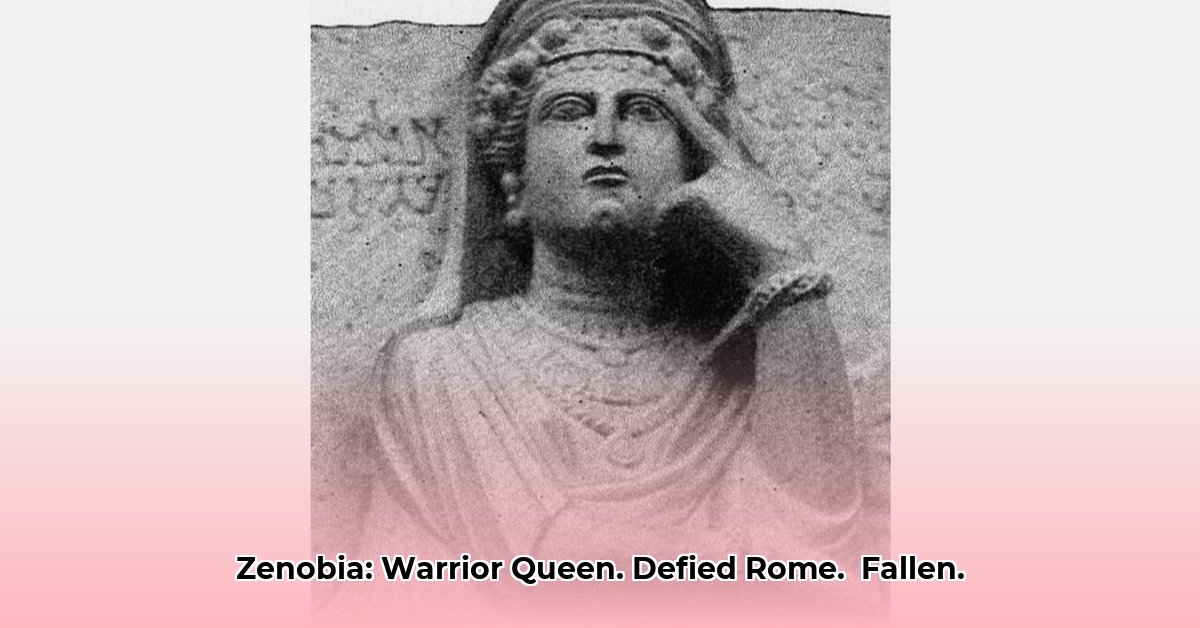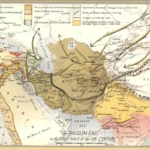Have you ever heard of Zenobia, the queen of Palmyra? She wasn’t just any royal figure; she was a force to be reckoned with. Zenobia ruled Palmyra, an ancient city brimming with wealth and influence, and fearlessly challenged the Roman Empire, one of history’s most formidable powers. This is the tale of her ascent to power, her strategic genius in building an empire, the allies who aided her, and the reasons Rome viewed her as a significant threat. For context on ancient legal systems, see ancient laws. Prepare for a captivating journey into the life of a queen who left an indelible mark on history.
Queen Zenobia of Palmyra: The Warrior Queen Who Defied Rome
Imagine a woman of immense power ruling a desert kingdom, a vital hub connecting ancient empires. That was Zenobia, queen of Palmyra, a city that shone radiantly with wealth and power in the third century A.D. Her life, a compelling blend of ambition, rebellion, and tragedy, echoes through the sands of time. But how much of what we know is fact, and how much is colored by the perspectives of her Roman conquerors? Let’s delve into Zenobia’s rise to power and her courageous defiance of Rome.
Palmyra: A Desert Oasis of Power
Located in modern-day Syria, Palmyra thrived in the shadow of the mighty Roman Empire. Initially a loyal ally, Palmyra flourished under Zenobia’s husband, Odaenathus, a brilliant military leader who expanded its influence across the Near East. Following his assassination in 267 or 268 AD, Zenobia, a woman of exceptional intelligence and capability, stepped into power.
She inherited a formidable army and a strategically vital location. Could she maintain Palmyra’s independence against the powerful Roman Empire? The odds were stacked against her, but Zenobia was not one to back down. Palmyra’s geographic location was pivotal, serving as a crucial trading post along the Silk Road. It facilitated the exchange of goods and ideas between the East and West, contributing significantly to its economic and cultural vibrancy. Learn more about Palmyra’s importance in ancient trade routes and its complex relationship with the Roman Empire.
A Queen’s Ambitions and Rome’s Growing Unease
Zenobia’s reign was defined by daring military campaigns. Her armies, composed of Palmyrene, Arab, and even Roman soldiers, successfully expanded Palmyrene control eastward into Persia and southward into Egypt. The conquest of Egypt was a direct challenge to Rome, significantly escalating tensions. The Roman Empire, already grappling with internal chaos during the Crisis of the Third Century, faced a formidable rival on its eastern frontier.
Was Zenobia simply seizing opportunities, capitalizing on Rome’s internal struggles? Or was she motivated by a deeper desire to establish an independent Palmyrene empire, free from Roman control? Historians continue to debate this question. Roman accounts portray her as a defiant rebel. However, the absence of a Palmyrene perspective makes it difficult to obtain a balanced view.
Some historians believe that Zenobia’s drive stemmed from Palmyra’s distinct cultural identity, separate from both Rome and the East. Perhaps she genuinely believed that Palmyra deserved its freedom. Or perhaps her defiance was a calculated strategy for survival in a turbulent world. The exact motivations of Zenobia may remain a mystery. Explore the complexities of Zenobia’s motivations and the factors that led to her rebellion against Rome.
The Clash and Fall of Palmyra
Emperor Aurelian of Rome could not tolerate Zenobia’s challenge. He launched a massive campaign to reclaim Egypt and crush Palmyra. Despite initial setbacks, Aurelian’s legions ultimately overpowered Palmyra’s forces. Zenobia’s reign came to an end in 272 AD with her defeat at the Battle of Emesa.
What became of Zenobia herself? Conflicting accounts offer different versions of her final days: a grand parade through Rome, execution, or a quiet exile. These varying accounts highlight the challenges of reconstructing history from fragmented and often biased sources. According to one account, after being captured, Zenobia was paraded in golden chains through Rome during Aurelian’s triumphal procession in 274 AD. However, Emperor Aurelian spared her life, and she was granted a villa in Tibur (modern-day Tivoli, Italy), where she lived out her days in relative comfort and even married a Roman senator.
Zenobia’s Enduring Legacy
Despite the gaps in the historical record, Zenobia remains a captivating figure. Her leadership qualities, her audacious defiance against overwhelming odds, and the tragic fall of her kingdom offer insights into power, ambition, and the human struggle for freedom. Her story stands as a potent reminder of a woman who bravely challenged the might of Rome, leaving behind a legacy that is as breathtaking as it is mysterious.
Contrasting Accounts: A Look at Conflicting Narratives
| Source Type | Zenobia’s Motives | Zenobia’s Fate | Reliability |
|---|---|---|---|
| Roman Historical Writings | Often portrayed as a power-hungry rebel. | Accounts vary: triumphal parade, execution, exile, marriage to a Roman Senator. | Potentially biased; Roman propaganda likely played a role. |
| Hypothetical Palmyrene Accounts* | Might have emphasized protecting Palmyrene interests and cultural identity. | Likely a more sympathetic portrayal, stressing dignity despite defeat and celebrating her achievements. | Unfortunately, very few primary Palmyrene sources survive, hindering a balanced view. |
*It’s essential to acknowledge that the scarcity of direct Palmyrene accounts poses a significant challenge to understanding events from their perspective.
The story of Zenobia, the warrior queen who dared to defy Rome, continues to intrigue historians and inspire ongoing debates. Her story underscores the limitations of historical sources and the importance of critical analysis. It is a story that invites further investigation, allowing us to better understand this exceptional woman and her place in history. The enigma surrounding her, along with the conflicting accounts, only adds to her enduring allure. Her legacy continues to encourage, reminding us that even in defeat, courage and defiance can leave an unforgettable mark. Consider the lasting impact of Zenobia’s rebellion and her place in historical narratives.
How did Zenobia’s strategic alliances influence Palmyra’s military campaigns against Rome?
Zenobia, the queen of Palmyra, was not only a powerful leader but also a shrewd strategist. Her ability to forge and leverage alliances was crucial to Palmyra’s ambitious military campaigns against Rome. How did these partnerships shape her wars? Let’s explore how Zenobia skillfully built alliances that proved vital for Palmyra’s military endeavors against Rome.
A Network of Power: Zenobia’s Alliances
Palmyra, a wealthy oasis city, was not inherently a military superpower. Zenobia’s brilliance lies in her ability to transform it into a major player through a strong network of alliances. She cleverly cultivated relationships, enhancing Palmyra’s military strength and challenging Roman dominance. These alliances were not fleeting agreements but carefully crafted relationships based on mutual benefits and strategic calculations.
One of Zenobia’s most significant alliances was with the Sasanian Empire of Persia. This powerful neighbor provided crucial military support, which was critical given Rome’s vast armies. The resources and manpower from Persia allowed Palmyra to conquer vast swathes of territory, including Egypt and parts of Asia Minor. This alliance was not without its complications. Navigating the complexities of relations with powerful Persia required considerable diplomatic skill and often meant walking a tightrope to ensure the stability of the alliance. How did Zenobia’s strategic alliances influence Palmyra’s military campaigns against Rome? The Persian alliance was a pivotal example.
Zenobia also cultivated ties with various tribal groups across the region. These relationships provided valuable intelligence, additional troops, and crucial local knowledge of the terrain. This local knowledge proved invaluable in numerous military campaigns, providing a distinct advantage over the Roman legions, who often struggled with the nuances of local landscapes. She was not just building an army; she was weaving a complex web of loyalties and support that enhanced her military capabilities.
Military Victories: The Fruits of Alliance
Zenobia’s network of alliances yielded tangible results. Her armies, strengthened by foreign support, conquered Egypt, a vital Roman province. This success was not solely due to military might; the political alliances provided the strategic foundation for this audacious campaign. The conquest of Egypt not only provided Palmyra with a treasure chest of resources, including grain, wealth, and manpower, but also amplified her strength and bolstered her defiance of Rome.
The subsequent campaigns against Roman forces in the Levant (the region encompassing present-day Israel, Palestine, Lebanon, Syria, and Jordan) also benefited greatly from these strategic partnerships. Local support and the presence of Persian troops allowed Zenobia’s forces to hold their ground against more numerous Roman legions in several pivotal battles. While the details of each battle remain debated amongst historians, the undeniable contribution of her alliances to the prolonged conflict is indisputable.
The End of an Alliance: The Fall of Palmyra
Despite her shrewd alliances, Zenobia’s rebellion ultimately failed. The Roman Emperor Aurelian, a formidable general, eventually crushed the Palmyrene forces. The reasons for her defeat are multifaceted, but the shifting sands of international alliances played their part. The Persian alliance, never a completely dependable one, wavered, leaving Zenobia more vulnerable. It illustrated the inherent fragility of alliances based on expediency rather than unbreakable bonds of loyalty.
Key Takeaways:
- Zenobia’s alliances were not merely military aids but critical components of her overall strategic vision.
- The alliance with Persia significantly increased Palmyra’s military capacity.
- Local alliances provided crucial intel and manpower, enhancing combat effectiveness.
- The alliance with Persia proved tenuous in the face of Roman military pressure.
- The unstable nature of these partnerships highlights the complexities of ancient diplomacy.
Zenobia’s Strategic Alliances and their Impact on Palmyrene Expansion
Key Takeaways:
- Zenobia skillfully used alliances to expand Palmyra’s influence.
- These alliances, however, ultimately proved insufficient against Rome’s might.
- Her shrewd diplomacy initially secured her gains, but Rome’s superior resources eventually prevailed.
A Desert Oasis Rises: Palmyra’s Strategic Location
Palmyra, a stunning city in the Syrian Desert, held a unique geopolitical advantage. Its location at the crossroads of vital trade routes connecting East and West made it strategically important. This crucial location allowed Zenobia to leverage existing trade networks and forge new alliances, positioning Palmyra as a key player in regional power dynamics. Imagine Palmyra as a bustling crossroads, attracting merchants, soldiers, and diplomats, all fueling its growth and power under Zenobia’s rule. This strategic position was the foundation of her audacious ambitions.
Forging Alliances: A Web of Power
Zenobia’s reign was not just about military might; it was about intelligent diplomacy. Her Zenobia’s Strategic Alliances and their Impact on Palmyrene Expansion were crucial. She skillfully formed alliances with various groups, including regional powers and nomadic tribes. These relationships provided her with essential military support and crucial resources, significantly enhancing her capacity for expansion. She shrewdly played different factions against each other, often using her charm and intellect to persuade. Her ability to forge alliances, especially with those who felt marginalized by Rome, was a key component to her initial successes.
Expanding the Empire: Conquest and Consolidation
The alliances Zenobia forged were not just for show; they powered Palmyra’s astonishing expansion. Her armies, bolstered by allied contingents, marched eastward and westward, conquering vast territories and expanding Palmyra’s sphere of influence. The conquest of Egypt was a significant achievement, dramatically increasing Palmyra’s wealth and power. But maintaining control over such a vast territory required constant deft maneuvering and further alliances, highlighting her leadership capabilities and underscoring the importance of strategic partnerships in empire-building. How did such a seemingly fragile oasis kingdom manage to conquer a region as rich and populous as Egypt? The answer lies in a combination of military prowess and diplomatic skill.
The Shifting Sands: The Limits of Alliances
Zenobia’s carefully constructed alliances, while effective initially, ultimately proved insufficient to withstand Rome’s enduring power. Rome, despite its internal struggles, possessed far greater resources and manpower. While Zenobia’s allies provided valuable support during her expansion, they couldn’t provide the lasting stability she needed to challenge Roman supremacy. Rome was a behemoth, and even Zenobia’s skillful maneuvering couldn’t prevent the eventual Roman counterattack. This underscores the limitations of strategic alliances against a superior power with extensive resources.
The Fall of Palmyra: A Legacy of Resistance
The Roman Emperor Aurelian’s eventual victory over Zenobia is a poignant reminder that even the most brilliant strategies can fail. Zenobia’s defiance of Rome, however, earned her a distinguished place in history. Her story serves as a powerful allegory for the enduring human spirit. It demonstrates the courage of individuals who dare to challenge even the most formidable empires, inspiring future generations with her bold ambitions and strategic brilliance. What can we learn from her ultimate failure? The importance of recognizing the limits of power, however cleverly wielded.
Zenobia’s Cultural Legacy: Palmyra’s Influence Beyond Her Reign
Key Takeaways:
- Zenobia’s reign saw Palmyra flourish culturally and economically.
- Her military prowess and defiance of Rome captivated later generations.
- Her legacy is complex, shaped by diverse interpretations and surviving sources.
- Zenobia’s Cultural Legacy: Palmyra’s Influence Beyond Her Reign extended through architecture, art, and the city’s unique blend of cultures.
- The debate surrounding her motives and the reliability of historical sources continues to fuel scholarly interest.
A Desert Oasis of Power
Imagine Palmyra, a shimmering oasis in the Syrian desert. This city, a crossroads of empires, pulsed with life under Queen Zenobia. Her reign, a breathtaking blend of military might and cultural splendor, left an enduring mark that still resonates today. How did a woman in a male-dominated world manage to command such power and leave such a lasting impact? Let’s delve into her story. Zenobia’s rise to prominence was not a smooth ascent. She inherited a kingdom already strategically significant, but her ambition transcended mere maintenance. She expanded Palmyra’s influence far beyond its traditional borders, conquering Egypt and challenging Rome itself. This act of defiance cemented her place in history. But what drove her ambitions? Was it ambition, a desire for independence, or something more profound? Understanding her complex motivations is key to understanding her legacy.
Military Triumphs and Cultural Flourishing
Zenobia’s military achievements are undeniable. Her armies, a formidable force blending Palmyrene, Roman, and Persian elements, achieved stunning victories. She controlled vast territories, even holding sway over Egypt for a time. Yet, her legacy isn’t solely defined by warfare. She fostered a vibrant cultural landscape within Palmyra, a city known for its architectural marvels and unique blend of Eastern and Western influences. Think of the magnificent colonnades, temples, and funerary monuments – a testament to her patronage and the city’s prosperity under her rule. This artistic influence extended beyond her lifetime. Zenobia’s Cultural Legacy: Palmyra’s Influence Beyond Her Reign is visible in the enduring architectural styles and artistic motifs that continue to fascinate historians and archeologists.
The Clash of Empires: Rome vs. Palmyra
Zenobia’s defiance of Rome, however, sealed her fate. Her rebellion, a bold challenge to the might of the Roman Empire, brought Aurelian, Rome’s emperor, to her doorstep. The ensuing conflict was dramatic, ending with Zenobia’s capture and the eventual fall of Palmyra. This dramatic clash isn’t just a historical event; it’s a story of ambition, resilience, and the clash of cultures that continues to captivate audiences today. It’s a story with many interpretations. Some see her as a selfless defender of Palmyra against imperial encroachment. Others portray her as a ruthless power-seeker, driven by personal ambition. Which is it? The truth, as often happens in history, is multifaceted and open to interpretation.
The Enduring Legacy
Despite her defeat, Zenobia’s legacy remains powerful. She’s become a symbol of female strength and resistance, particularly for Arab and Middle Eastern cultures, where she is celebrated as a national heroine. Her story has inspired countless literary works and artistic interpretations, transforming her from a historical figure into a legendary queen. Her impact on Palmyra’s cultural identity continues to resonate today, even as the city grapples with the ravages of time and conflict. Understanding this legacy requires analyzing diverse historical accounts and recognizing the inherent biases embedded in ancient narratives. Her story is a reminder of the complexities of power, the enduring strength of cultural identity, and the enduring fascination with queens who defied empires.
A Multifaceted Legacy: Unraveling the Myths
The sources available about Zenobia vary significantly in terms of accuracy and perspective. The Historia Augusta, for instance, often presents romanticized and sometimes unreliable accounts, while archaeological evidence offers a different, more tangible perspective on Palmyra’s prosperity under her reign. This presents a significant challenge to historians: how do we sift through the biases and arrive at a balanced understanding of this remarkable woman and her legacy? Scholars continue to debate her motivations, the extent of her power, and the precise circumstances of her capture and later life. This constant re-evaluation is crucial to understanding her complex influence. Zenobia’s Cultural Legacy: Palmyra’s Influence Beyond Her Reign remains a topic of ongoing scholarly debate that is enriched by archeological discoveries and new interpretive frameworks.
















